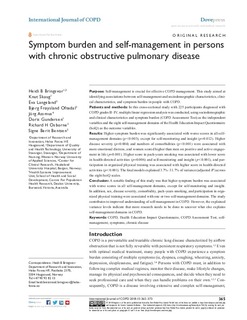| dc.contributor.author | Bringsvor, Heidi Breistrand | |
| dc.contributor.author | Langeland, Eva | |
| dc.contributor.author | Oftedal, Bjørg Frøysland | |
| dc.contributor.author | Skaug, Knut | |
| dc.contributor.author | Assmus, Jörg | |
| dc.contributor.author | Gundersen, Doris Irene | |
| dc.contributor.author | Osborne, Richard H | |
| dc.contributor.author | Bentsen, Signe Berit | |
| dc.date.accessioned | 2018-04-11T08:37:48Z | |
| dc.date.available | 2018-04-11T08:37:48Z | |
| dc.date.created | 2018-03-26T20:03:59Z | |
| dc.date.issued | 2018-01 | |
| dc.identifier.citation | Bringsvor, H.B. et al. (2018) Symptom burden and self-management in persons with chronic obstructive pulmonary disease. The International Journal of Chronic Obstructive Pulmonary Disease. 13, pp. 365-373. | nb_NO |
| dc.identifier.issn | 1176-9106 | |
| dc.identifier.uri | http://hdl.handle.net/11250/2493571 | |
| dc.description.abstract | Purpose: Self-management is crucial for effective COPD management. This study aimed at identifying associations between self-management and sociodemographic characteristics, clinical characteristics, and symptom burden in people with COPD.
Patients and methods: In this cross-sectional study with 225 participants diagnosed with COPD grades II–IV, multiple linear regression analysis was conducted, using sociodemographic and clinical characteristics and symptom burden (COPD Assessment Test) as the independent variables and the eight self-management domains of the Health Education Impact Questionnaire (heiQ) as the outcome variables.
Results: Higher symptom burden was significantly associated with worse scores in all self-management domains (p<0.003), except for self-monitoring and insight (p=0.012). Higher disease severity (p=0.004) and numbers of comorbidities (p<0.001) were associated with more emotional distress, and women scored higher than men on positive and active engagement in life (p=0.001). Higher score in pack-years smoking was associated with lower score in health-directed activities (p=0.006) and self-monitoring and insight (p<0.001), and participation in organized physical training was associated with higher score in health-directed activities (p<0.001). The final models explained 3.7%–31.7% of variance (adjusted R2) across the eight heiQ scales.
Conclusion: A notable finding of this study was that higher symptom burden was associated with worse scores in all self-management domains, except for self-monitoring and insight. In addition, sex, disease severity, comorbidity, pack-years smoking, and participation in organized physical training were associated with one or two self-management domains. The study contributes to improved understanding of self-management in COPD. However, the explained variance levels indicate that more research needs to be done to uncover what else explains self-management domains in COPD. | nb_NO |
| dc.language.iso | eng | nb_NO |
| dc.publisher | Dove Press | nb_NO |
| dc.rights | Navngivelse-Ikkekommersiell 4.0 Internasjonal | * |
| dc.rights.uri | http://creativecommons.org/licenses/by-nc/4.0/deed.no | * |
| dc.subject | COPD | nb_NO |
| dc.subject | lungesykdommer | nb_NO |
| dc.subject | self-management | nb_NO |
| dc.subject | selvregulering | nb_NO |
| dc.subject | kronisk sykdom | nb_NO |
| dc.title | Symptom burden and self-management in persons with chronic obstructive pulmonary disease | nb_NO |
| dc.type | Journal article | nb_NO |
| dc.type | Peer reviewed | nb_NO |
| dc.description.version | publishedVersion | nb_NO |
| dc.rights.holder | © 2018 Bringsvor et al. | nb_NO |
| dc.subject.nsi | VDP::Medical disciplines: 700::Clinical medical disciplines: 750::Lung diseases: 777 | nb_NO |
| dc.source.pagenumber | 365-373 | nb_NO |
| dc.source.volume | 13 | nb_NO |
| dc.source.journal | The International Journal of Chronic Obstructive Pulmonary Disease | nb_NO |
| dc.identifier.cristin | 1575844 | |
| cristin.unitcode | 217,13,0,0 | |
| cristin.unitname | Det helsevitenskapelige fakultet | |
| cristin.ispublished | true | |
| cristin.fulltext | original | |
| cristin.qualitycode | 1 | |

